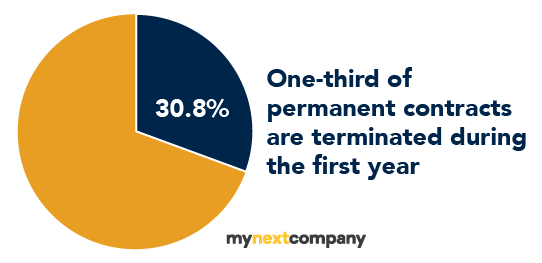
If you think it’s expensive to hire a professional, wait until you hire an amateur.” Red Adair
When recruiting new people for your company, it is essential to consider the cost of the new hires within your allocated budget. However, while we consistently consider the direct costs of new employees, namely their salary, social security contributions, bonuses and various other benefits, we tend to overlook the costs associated with finding (or, worse still, not finding) the talent needed.
How to evaluate the cost of recruitment
The indirect costs of recruitment can be pretty high. The costs cover outlining a profile and job description, selecting channels on which to post the ad, publishing the job ad, etc. However, a far higher cost is the salary time of other employees spent on recruitment: processing CVs, interviewing candidates and holding internal meetings to select the right candidate are just the beginning.
According to various studies, the cost of recruitment and integration is estimated at between 15% and 25% of the new employee’s gross annual salary. To get an idea of the real cost involved, calculate the hourly cost (gross salary + employer contributions + tax charges, etc.) of the employees involved multiplied by the time spent on each phase (drafting the ad, analysing applications, holding interviews, etc.) For the sake of this article and the example we outline later, we will assume an average cost of recruitment at 20% of the employee’s gross annual salary.
Calculate the actual cost of recruitment
HOURLY COST (gross salary + employer contributions + tax charges, etc.) of the employees involved x
TIME spent on each phase
Looking for a cheaper way of finding IT profiles? As developers are amongst the most rare profiles on the job market, we know that finding the one that will fit your needs is not easy. Luckily, help is on the way! Mynextcompany.io is the new Belgian platform that directly connects you with developers. Give it a try and see for yourself!
What happens when you don’t find the right people?
There are few things more frustrating for a business owner than having a long pipeline of orders and exciting growth plans, but then struggling to find the right people to make these a reality. Not being able to deliver on time and thus slowing down company growth are two of the main risks of insufficient staffing. This in turn might lead to a decline in the company’s reputation, or even a loss of clients and market share.
On top of the financial disadvantages of this situation, it’s also important to consider the human factor and the distress and difficulty caused to current team members. Existing employees often feel frustrated and obliged to do more work in order to compensate for the missing resources. The management is under pressure to deliver results. This creates additional stress and may cause an increased number of errors, which then leads to a drop in team morale, absenteeism, burnout and even loss of valuable employees.
What happens when you hire the wrong people?
The risks linked to understaffing are so high that some business owners may feel urged to take hasty recruitment decisions and potentially hire people who are not a good match for the role or organisation, or who do not have the necessary motivation and will leave within a few months.
 An Acerta survey found that 30,3% of permanent contracts in Belgium are terminated during the first year either by the employee or employer (26,3% for white-collar workers), but it is the company that has to bear the costs of terminating the contract and launching a new recruitment drive.
An Acerta survey found that 30,3% of permanent contracts in Belgium are terminated during the first year either by the employee or employer (26,3% for white-collar workers), but it is the company that has to bear the costs of terminating the contract and launching a new recruitment drive.
However, unmotivated or unskilled employees already bring losses when still working at the company. The operating loss is linked to the added value not received by the company, compared to the investment made. This cost can be estimated at at least 1.5 times the employee’s wage and may increase or even double depending on the company’s activity, the operating margin rate and the ratio of personnel costs to gross operating income.
The cost of unsuccessful hires
Let’s take a look at the following example. A new employee receives a gross monthly salary of €3,000. This amounts annually to €3,000 x 13.92 months: 12 months’ salary, and 1.92 months representing holiday pay = equalling €41,760 per year.
As mentioned earlier, the cost of recruitment and integration of the employee is estimated at between 15 and 25% of the employee’s annual salary. For this calculation, we will use the average of 20%, which amounts to €8,352.
Imagine that the contract is terminated after 2 months. During these 2 months, the employee received a gross salary of €6,000. Taking into account employers’ fees, the holiday pay and other social and fiscal charges, the cost to the employer is multiplied by at least 1.8, which amounts to €10,800.
To account for the operating loss due to the added value not received by the company, this amount can be multiplied again by 1.5, equalling €16,200.
The grand total cost of this unsuccessful hire totals €24,552 and will increase further due to the administrative costs of termination of the contract, which will vary from organisation to organisation.
EXAMPLE: Cost of an unsuccessful hire
Recruitment and onboarding: €8,352 +
(2-month salary cost to employer: €10,800 x
1.5 operating loss: €16.200) =Total cost: €24,552
This example allows us to estimate the cost of this particular unsuccessful hire at least €24,552. For companies experiencing a growth spurt, such as scaleups or larger companies branching out into new areas of activity and needing to hire many employees, this can represent a crushing loss.
Imagine a company that is very successful and needs to hire 50 new people this year. Statistically, out of these 50 people, 26.3% or 13 people will leave within the first year, according to the Acerta study we mentioned earlier. The cost of this failed recruitment will total €319,176 in this one year alone.
EXAMPLE: Potential annual loss (50 hires/year)
Loss incurred by one employee: €24,552 x
13 employees that will leave within 1 year =Total annual loss: €319,176
Conclusion
It’s therefore clear that unsuccessful recruitment can be at least as harmful to a company and its employees as no recruitment at all. In order to prevent such a serious situation and the associated financial losses, it’s vital to improve the overall recruitment process.
One way to achieve this is by using an external recruitment company. The cost of their services is considerably lower than the total of all internal costs, and generally includes a replacement guarantee if the person employed breaks the contract during the defined trial period.
It’s crucial to choose the right agency, especially if your business is experiencing intense growth and is likely to need to hire lots of people. The agency you choose needs to have the right long-term strategy to assist you with your recruitment needs. Our Smart Recruiting® method combines digital tools and marketing strategy for fast, efficient, and qualitative recruitment. Click on the button below for more information.

Recent Comments